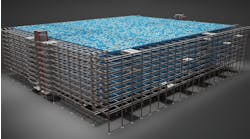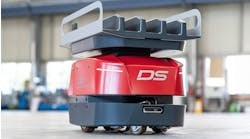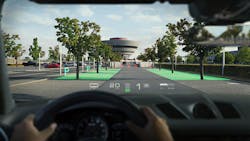The global automotive industry is widely believed to be on the cusp of tremendous change in terms of manufacturing, sales, and the overall business model, owing to the rapid advances in new-age technologies such as autonomous driving, augmented reality, and big data. Consequently, various ancillary verticals of the automotive industry are undergoing a fundamental transformation due to these technological enhancements. The automotive display market is one such vertical that has embraced these technologies seamlessly, thus boosting its commercialization prospects.
Although there’s increased attention on ride sharing and driverless cars, the demand for conventional automobiles remains strong considering the fact that global sales of passenger cars and trucks exceeded a whopping USD 90 million for the first time in 2017. This irrefutably explains the growth momentum of the global automotive display market, which is slated to exceed USD 30 billion by 2025, as per Global Market Insights Inc.
Rising Adoption of OLED Technology
Primarily, visualization technologies are the most vital components of in-vehicle interactions, with overall automotive navigation and connectivity characterizing the cars of this generation. As a result, the incorporation of interactive displays (those that are highly responsive to touch and visual stimulus) has become a key feature of manufacturing processes deployed by prominent automakers.
In this regard, OLED displays are gradually emerging as the most preferred display-panel technology among automotive companies such as General Motors, Audi, Toyota, Volkswagen, and Mercedes-Benz. A couple of examples:
- Mercedes Benz is set to launch its new cars with OLED panels developed by LG Display in dashboards and rear-seat monitors from the year 2020. Vehicles with OLED displays are unveiled at various exhibitions almost regularly, but Mercedes-Benz would become the very first automaker to utilize OLEDs into its consumer models.
- In 2018, Audi introduced its latest car model, the E-Tron Quattro, which features rear-view cameras connected with 7-inch OLED monitors. This arrangement ensures that different angles and views are displayed on the OLED monitors inside the vehicle.
Better visibility, picture quality, and sharpness than TFT LCD screens are the unique selling propositions (USPs) of OLED display panels. That’s why the automotive display market is witnessing a sustained growth in the highly competitive global auto sector.
How Has Auto Display Industry Secured a Vital Spot in the Driverless Revolution?
Fully driverless technology is still at an advanced testing stage. However, it’s correct to assume that autonomous cars are right around the corner, thanks to the massive investment being made by world’s most renowned tech corporations and automotive giants. Tesla has been testing its driverless Autopilot system on UK roads, Google is developing its automated technology across the Atlantic, Apple is working with BMW to build a new driverless car, and auto makers such as Mercedes and Lexus are at the forefront of developing autonomous car technology.
Even though advanced driver-assistance systems (ADAS) such as park assistance, forward collision, lane-departure warnings, and blind-spot monitoring are frequently hailed as the technologies that will usher us into an age of autonomous transportation, drivers are still either untrusting or too trusting of these features. This has led to an evolution of sorts in the in-car user experience interfaces, and more so with the way automotive display makers are developing new products.
The Consumer Electronic Show 2017, in particular, showcased an exciting future for the application of a new generation of automotive displays. Whether it’s Audi’s concept vehicle with ergonomic conformal displays; Hyundai’s display-based dash, central console, and in-door wing mirrors; or Nissan’s dash and console displays, the need for lightweight and transparent displays that offer unobtrusive visual information during journeys is on the rise. Head-up displays are fast gaining popularity as an ideal interface for disseminating crucial information such as navigation messages, vehicle speed, and warnings.
The shift toward autonomous vehicles and connected cars is preparing for a future in which occupants would be required to monitor the status of the vehicle and its surroundings. As such, the global automotive display market forecast reveals substantial growth over the coming years as the car’s interior goes digital, with a substantial increase in the requirement for larger displays.
Augmented Reality Will Disrupt the Display Market
With the onslaught of digitization, automation, and transformative business models, the global automotive sector is experiencing profound changes in the manufacture and sale of new vehicles. At one time, the sign of an automotive firm doing exceptionally well was that if it created ads of its new offerings with big-ticket investments at exotic locales. However, almost all major automakers now shun this trend, with the focus shifting toward providing customers with technology-driven premium experiences.
When it comes to integrating the latest automotive-display technologies, augmented reality has become the most popular in terms of projecting precise digital information on the windshields. Needless to say, these brands are weaving impactful experiences around new AR solutions that have a human touch in an increasingly automated world. In this regard, the AR head-up displays showcased at the Consumer Electronics Show 2019 are a testimony to how automotive displays would not be limited to relegating data to a small corner of the display, but expand to the whole windshield.
WayRay's new AR head-up display was exhibited at CES 2019.
For example, WayRay, a manufacturer of holographic AR technology solutions, revealed a new AR head-up display that overlays 3D animation onto whatever the driver sees ahead. The system could be used to improve current in-car navigation systems.
In addition, WayRay provides a True AR Software Development Kit that enables third-party developers to add their own creations to the windshields, essentially revolutionizing the way AR can be deployed across automotive-display industry. The launch of the new head-up displays is invariably linked to the steady advance of semi-autonomous and autonomous cars, which would use AR to keep passengers entertained throughout their journey.
Evidently, the concept of having a tiny screen for the central console and CD players for basic operations has changed entirely with larger, technically advanced, and more efficient displays gaining mass acceptance. Taking into account the progress being made in integrating newer technologies in the automotive-display industry, cars of the future will no doubt be equipped with highly customized display panels that would serve the purposes of safety, entertainment, and efficient navigation.
Saif Ali Bepari is a Content Developer at Global Market Insights Inc.












